-
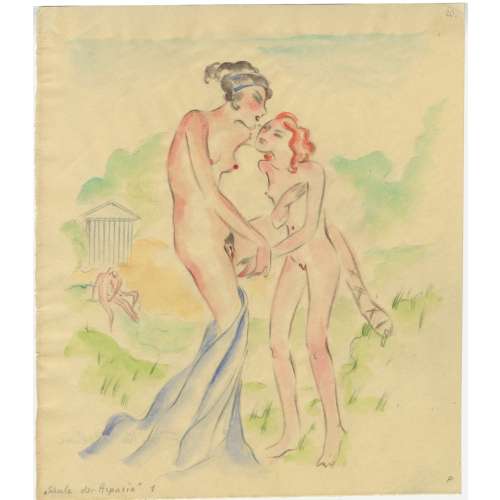 NEWPencil and watercolour on paper 230 x 197 mm, pencil ms inscription in the bottom-left “Schule der Aspasia” 1 (2, 3), monogrammed “P” in the bottom-right, and “Erika Plehn” to verso. Apparently, illustrations for ‘Die Weisheiten der Aspasia’ also known as ‘Die Dirnenschule der Aspasia’ (Aspasia's prostitute school), an erotic novel by Fritz Thurn (Foregger), privately published in Vienna in 1923. Artist: Erika Plehn [née Erika Pinkus] (German, 1904 – 1988) Author: Fritz Thurn [Foregger zum Greiffenthurn] (Austrian, 1877 – 1938). Aspasia of Miletus (Greek, c. 464 BCE – c. 420 BCE)
NEWPencil and watercolour on paper 230 x 197 mm, pencil ms inscription in the bottom-left “Schule der Aspasia” 1 (2, 3), monogrammed “P” in the bottom-right, and “Erika Plehn” to verso. Apparently, illustrations for ‘Die Weisheiten der Aspasia’ also known as ‘Die Dirnenschule der Aspasia’ (Aspasia's prostitute school), an erotic novel by Fritz Thurn (Foregger), privately published in Vienna in 1923. Artist: Erika Plehn [née Erika Pinkus] (German, 1904 – 1988) Author: Fritz Thurn [Foregger zum Greiffenthurn] (Austrian, 1877 – 1938). Aspasia of Miletus (Greek, c. 464 BCE – c. 420 BCE) -
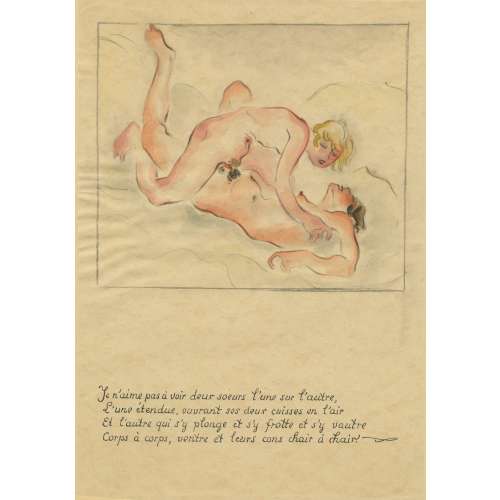 NEWFramed pencil and watercolour drawings with 4-line manuscript pen and ink French text under the frame on paper 255 x 175 mm mounted on card stock sheets 290 x 210 mm. Illustrations correspond to the 1st edition of Pierre Louÿs’ « Pybrac / Poésies » published by Cythère Au coq hardi in 1927 [LIB-3061.2022], pp. 25, 37, 64, 69, 85, 86, and 94. Illustrations here are placed in the order they would have appeared in the book.
NEWFramed pencil and watercolour drawings with 4-line manuscript pen and ink French text under the frame on paper 255 x 175 mm mounted on card stock sheets 290 x 210 mm. Illustrations correspond to the 1st edition of Pierre Louÿs’ « Pybrac / Poésies » published by Cythère Au coq hardi in 1927 [LIB-3061.2022], pp. 25, 37, 64, 69, 85, 86, and 94. Illustrations here are placed in the order they would have appeared in the book.- Je n’aime pas à voir deux sœurs l’une sur l’autre, L’une étendue, ouvrant ses deux cuisses en l’air, Et l’autre qui s’y plonge et s’y frotte et s’y vautre, Corps à corps, ventre à ventre et leurs cons chair à chair.
- Je n’aime pas à voir la douce concubine Qu’on encule toujours et qui, d’un doigt lascif Se branle le bouton, se tire la barbiche, Pour soulager son cul douloureux et passif
- Je n’aime pas à voir cette Sappho mascule Qui, dans sa chambre, habille une fille en garçon, Lui baisse la culotte et froidement l’encule Avec un godmiché plus gros qu’un saucisson.
- Je n’aime pas à voir la vierge au doigt lubrique Qui, les deux pieds en l’air, masturbe sur le lit Son pucelage en rut, gonflé, couleur de brique, Et décharge en baisant le roman qu’elle lit.
- Je n’aime pas à voir le garçon sur la fille Donner des coups au cul et danser le galop Aux applaudissements de toute la famille Qui dit : « Ça vient, putain ! Fais-la jouir, salop ! »
- Je n’aime pas à voir la princesse de Grèce, Qui, menée au bordel par sa fille d’honneur, Frotte sa bouche obscène au cul de la négresse Et crie en déchargeant : « C’est là qu’est le bonheur ! »
- Je n’aime pas à voir dans un bal de familles Que l’hôtesse dispose une chambre d’ami Et des lits de repos, au gré des jeunes filles, Pour sucer leurs danseurs ou se faire mimi.
-
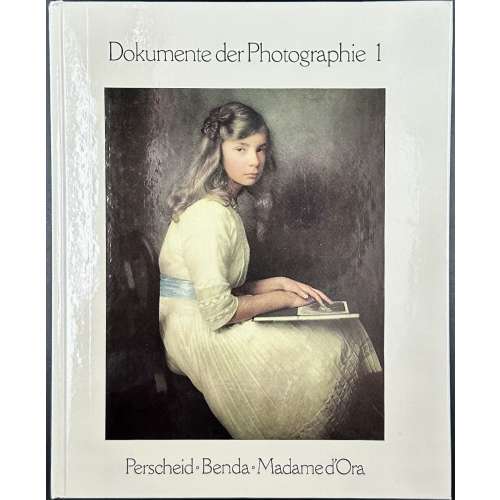 NEWHardcover, 240 x 192 mm, glossy pictorial boards, lettering to front and spine, pp.: [1-5] 6-171 [172], with 308 plates in colour and b/w. Catalogue of the exhibition held on March 26 – June 1, 1980, at Museum für Kunst und Gewerbe in Hamburg. Title-page: DOKUMENTE DER PHOTOGRAPHIE 1 | FRITZ KEMPE | NICOLA PERSCHEID | ARTHUR BENDA | MADAME D'ORA | Katalog bearbeitet | von Odette M. Appel-Heyne | MUSEUM FUR KUNST UND GEWERBE HAMBURG 1980 || Contributors: Kempe, Fritz (German, 1909 –1988) – author Appel-Heyne, Odette M. – editor Kallmus, Dora [Madame d’Ora] (Austrian-Jewish, 1881 – 1963) – photographer Perscheid, Nicola (German, 1864 – 1930) – photographer Benda, Arthur (German, 1885 – 1969) – photographer
NEWHardcover, 240 x 192 mm, glossy pictorial boards, lettering to front and spine, pp.: [1-5] 6-171 [172], with 308 plates in colour and b/w. Catalogue of the exhibition held on March 26 – June 1, 1980, at Museum für Kunst und Gewerbe in Hamburg. Title-page: DOKUMENTE DER PHOTOGRAPHIE 1 | FRITZ KEMPE | NICOLA PERSCHEID | ARTHUR BENDA | MADAME D'ORA | Katalog bearbeitet | von Odette M. Appel-Heyne | MUSEUM FUR KUNST UND GEWERBE HAMBURG 1980 || Contributors: Kempe, Fritz (German, 1909 –1988) – author Appel-Heyne, Odette M. – editor Kallmus, Dora [Madame d’Ora] (Austrian-Jewish, 1881 – 1963) – photographer Perscheid, Nicola (German, 1864 – 1930) – photographer Benda, Arthur (German, 1885 – 1969) – photographer -
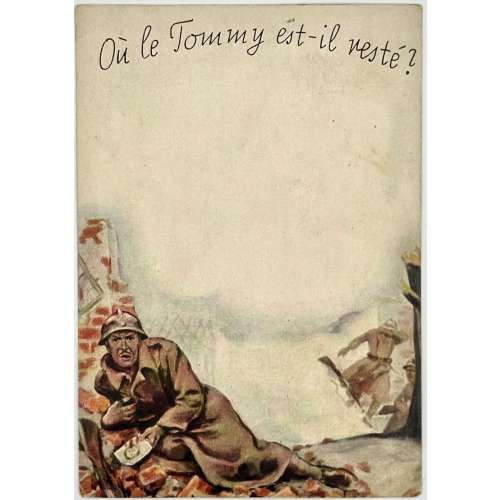 One of a series of six anti-allies propaganda cards, printed in colour, inscribed Ou le Tommy est-il resté? (Where did Tommy stay?), where Tommy is slang for a common soldier in the British Army. The postcards visibly depict French soldiers who fight and die at the western front, while the covert watermark image shows a British military having fun in a bordello. Those cards were printed in the Third Reich for France and dropped from aeroplanes to motivate French soldiers to fight against the British. Size: 149 x 104 mm
One of a series of six anti-allies propaganda cards, printed in colour, inscribed Ou le Tommy est-il resté? (Where did Tommy stay?), where Tommy is slang for a common soldier in the British Army. The postcards visibly depict French soldiers who fight and die at the western front, while the covert watermark image shows a British military having fun in a bordello. Those cards were printed in the Third Reich for France and dropped from aeroplanes to motivate French soldiers to fight against the British. Size: 149 x 104 mm -
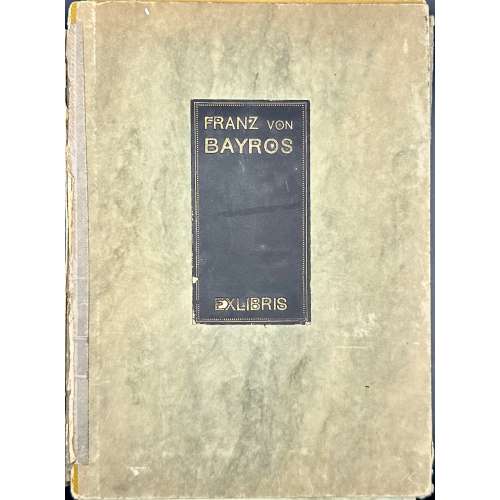 A set of 49 prints, heliogravures and etchings, tipped-in on 285 x 257 mm grey cards, in a green marbled folder with a gilt-lettered black label to the front. No publisher, no place, no year (s.l., s.n., s.d.), printed in circa 1910.
A set of 49 prints, heliogravures and etchings, tipped-in on 285 x 257 mm grey cards, in a green marbled folder with a gilt-lettered black label to the front. No publisher, no place, no year (s.l., s.n., s.d.), printed in circa 1910.- Vlastimil Blažek (Czech, 1878 – 1950): heliogravure, sheet 180 x 137 mm, plate 152 x 114 mm; laid paper, black sepia ink; unsigned.
- Ex libris Gerhard Wunderlich (architect in Dresden): heliogravure, sheet 205 x 150 mm, plate 158 x 115 mm; wove paper, brown sepia ink; inscription: heliogravure, sheet 180 x 137 mm, plate 152 x 114 mm; laid paper, sepia ink; inscription to top “Es ist alles so eng”; signed “F (backwards). Bayros”.
- Ex libris William Lipka: heliogravure, sheet 140 x 125 mm, plate 112 x 98 mm; laid paper, black sepia ink; signature hardly legible.
- Nikolaus Schindler (amateur photographer in Vienna): heliogravure, sheet 142 x 150 mm, plate 110 x 117 mm; laid paper, black sepia ink; unsigned.
- Sussy de Coiquard: heliogravure, sheet 160 x 140 mm, plate 128 x 110 mm; laid paper, black sepia ink; unsigned.
- Illegible, looks like “Vielluer Febréy”: heliogravure, sheet 120 x 109 mm, plate 93 x 85 mm; laid paper, black, sepia ink; signed “F (backwards). Bayros:”.
- Ex libris Erich Liebermann-Rosswiese (Greman-Jewish, 1886 – 1942): heliogravure, sheet 180 x 139 mm, plate 118 x 88 mm; wove paper, black sepia ink; unsigned.
- Ex libris Dr. phil. Rudolf Ludwig: before letters, heliogravure, sheet 150 x 132 mm, plate 120 x 110 mm; laid paper, black sepia ink; unsigned. See [LIB-3258.2023] John Cleland. Die Memoiren der Fanny Hill. — Paphos [i.e. Vienna]: C. W. Stern, 1906.
- Unidentified: before letters, heliogravure, sheet 150 x 115 mm, plate 113 x 88 mm; laid paper, black sepia ink; signed “F. Bayros” in the manuscript. Circumstantial evidence tells that this bookplate belongs to someone A.W.(Artur Wolf). See №22.
- Lulu. Monachia. Gest. v. Ritter Dialekt und Junker Erich: heliogravure, sheet 204 x 152 mm, plate 160 x 118 mm; wove paper, black sepia ink; unsigned. See №20.
- Kellner Jstván: (István): heliogravure, sheet 118 x 100 mm, plate 85 x 70 mm; laid paper, black sepia ink; signed “Franz Bayros” in the script (hardly legible).
- Adyton: heliogravure, sheet 170 x 130 mm, plate 113 x 85 mm; wove paper, black, sepia ink; signed “F (backwards). Bayros”.
- 13.Ex libris George Arthur Buhl (American, 1883 – 1959): heliogravure, sheet 166 x 140 mm, plate 120 x 92 mm; wove paper, black sepia ink; inscription “!I will! | !And I can!”; bust inscribed “T. Carlyle”; signed “F (backwards). Bayros” (hardly legible).
- Ex-Libris Heinrich und Lise Fuhrmann: heliogravure, sheet 165 x 149 mm, plate 120 x 103 mm; wove paper, black sepia ink; signed “F (backward). Bayros”; inscription “So schaff ich am sausenden Webstuhl der Zeit und wirke der Gottheit lebendiges Kleid” (from ‘Faust’ by Goethe).
- Ex libris Gerhard Wunderlich (architect in Dresden): heliogravure, sheet 165 x 137 mm, plate 135 x 105 mm; laid paper, black, sepia ink; signed “F (backwards). Bayros”.
- Ex Libris Walther u. Amelia Fahrenhorst; Walter Fahrenhorst (German, 1871 – 1938): heliogravure, sheet 165 x 140 mm, plate 128 x 95 mm; wove paper, black sepia ink; signed “F. Bayros” in the manuscript. The inscription behind the strings: NITOR (lat. beauty, glamour).
- Ex Libris Margot Lewknecht; heliogravure, sheet 145 x 140 mm, plate 128 x 118 mm; laid paper, black sepia ink; signed “F. Bayros”.
- Ex Libris Walther Heinisch (publisher in Carlsbad); heliogravure, sheet 185 x 145 mm, plate 140 x 110 mm; wove paper, sanguine; male bust with an inscription to the base: “Arnold Boeklin” / Arnold Böcklin (Swiss, 1827 – 1901); inscription: “mit gêru scal man geba infâhan” – a line from Hildebrandslied, the earliest poetic text in German. Unsigned.
- Bookplate with music score GGDBGC; heliogravure, sheet 125 x 135 mm, plate 100 x 110 mm, with monogram «HCJ»; laid paper, brown sepia ink; signed “F. Bayros”.
- Bookplate with inscription: Lulu aus Praga | Gest v. Ritter Dialekt / Monachia / Monachia / und Junker Erich; heliogravure, sheet 182 x 147 mm, plate 160 x 120 mm, image 122 x 105 mm; wove paper, bluish-black sepia ink; unsigned. See №10.
- Bookplate, no inscription; heliogravure, laid paper, sepia ink, sheet 148 x 127 mm, image 84 x 79 mm; signed F. Bayros in the manuscript beneath the image.
- Ex libris Artur Wolf: heliogravure, laid paper, sepia ink, sheet 170 x 150 mm, image 120 x 105 mm; signed F. Bayros in the manuscript to the frame of the image. See №9.
- Ex Libris E. K. Weigl: heliogravure, laid paper, sepia ink, sheet 139 x 121 mm, plate 112 x 97 mm; unsigned; inscription above male portrait: “LEONARDO”.
- Ex libris Dr. A. Bergmann: heliogravure, wove paper, sepia ink; sheet 180 x 140 mm, plate 130 x 105 mm; signed F. Bayros in the manuscript.
- Grete Cäcilie (monogram “PS”): heliogravure, laid paper, sepia ink, sheet 161 x 130 mm, plate 128 x 103 mm, signature illegible.
- Emma Steigleder: heliogravure, laid paper, black ink, sheet 181 x 141 mm, plate 158 x 117 mm, signed F. Bayros in the manuscript. Inscription “Si vis amari, ama! Seneca” [If you want to be loved, love] to the attic of the arch.
- Bruno Fischer: heliogravure, laid paper, sepia ink, sheet 186 x 145 mm, plate 155 x 116 mm, signed “F (backward). Bayros”. Inscription to bottom “Gehl Weck’ ihn nicht auf seien wir froh dass er einmal schläft!”
- Harnasch: heliogravure, wove paper, sepia ink; unsigned; sheet 140 x 132 mm, plate 100 x 85 mm; unsigned.
- Eduard Klampfl: heliogravure, laid paper, sepia ink, sheet 165 x 145 mm, plate 135 x 110 mm, signed “F (backwards). Bayros”; portrait bust of the composer Richard Wagner (German, 1813 –1883).
- Jorge Monsalvatje: heliogravure, wove paper, sepia ink; sheet 189 x 160 mm, plate 150 x 115 mm; signed F. Bayros in the manuscript.
- E. K. W.: wove paper, sepia ink; sheet 150 x 120 mm; signed “Bayros”.
- Unidentified bookplate: wove paper, sepia ink; sheet 150 x 120 mm; signed “F. Bayros 09” in the manuscript.
- Ex-Libris Helene and Emil Lemberger: heliogravure (or soft ground etching), laid paper, sepia ink, sheet 180 x 163 mm, plate 150 x 130 mm, signed “F. Bayros” in the manuscript.
- M. Z.: wove paper, sepia ink; sheet 130 x 170 mm, plate 90 x 120 mm; signed “F (backwards) Bayros”.
- Ex libris Frankl Frigyes Vilmos: heliogravure (or soft ground etching), laid paper, sepia ink, sheet 140 x 148 mm, unsigned. Frigyes Frankl, born in Tejfalu, Szlovákia, died in 1943.
- Ex libris Anton Bürck: heliogravure, wove paper, sepia ink; sheet 170 x 137 mm, plate 123 x 104 mm; unsigned. Anton Burck (German,1881 – 1951) of Palatinate, Bavaria.
- Aus den büchern A. W.: heliogravure, laid paper, sepia ink, sheet 152 x 136 mm, plate 120 x 105 mm, signed “F. Bayros” in the manuscript.
- Ex libris Hans Hickl: heliogravure, laid paper, sepia ink, sheet 150 x 125 mm, plate 115 x 95 mm, signed “Ω”.
- Ex libris Karl Wehle: soft ground etching, laid paper, brown sepia ink, sheet 107 x 90 mm, plate 80 x 65 mm, inscription “Gut!” in the centre; unsigned. Karl Wehle (Austrian, 1901 – 1933)
- Ex libris Dr. Paul Berger: etching, laid paper, black ink, sheet 140 x 115 mm, plate 115 x 85 mm, signed “F (backwards). Bayros”.
- Unidentified bookplate: etching, laid paper, black ink, sheet 145 x 115 mm, plate 85 x 70 mm, unsigned.
- Ex Bibliotheca Erotica Carl Georg von Maassen: soft ground etching, india paper, black ink, sheet 76 x 78 mm, signed “FB”.
- Ex Bibliotheca Erotica Carl Georg von Maassen: soft ground etching, india paper, black ink, sheet 79 x 79 mm, signed “F. von Bayros”.
- Paul Mixa: soft ground etching, laid paper, sanguine ink, sheet 122 x 111 mm, plate 90 x 85 mm, inscription: “Gerne hör’ich wenn du singest und ich horche wenn du schweigest” [I like to hear when you sing and I listen when you are silent].
- Ex libris Drs Q. M. Vyskocil.: etching, laid paper, sanguine ink, sheet 141 x 115 mm, plate 115 x 75 mm, inscription: “MIT REINEN HAENDEN” [with pure hands], signed “F. Bayros” in the manuscript.
- Ex libris Andrée Bearn de Riquer: soft ground etching, laid paper, sanguine ink, sheet 136 x 88 mm, plate 100 x 62 mm, signed “F (backwards). Bayros”. Andrée Béarn [Marguerite Laborde] (French, 1880 – 1973), spouse of Alexandre de Riquer (Catalan, 1856 – 1920).
- Ex musicis Drs Blažek VL: etching, wove paper, sanguine ink, sheet 141 x 116 mm, plate 115 x 90 mm, inscription: “MIT REINEN HAENDEN” [with pure hands], signed “F. Bayros” in the manuscript. See Vlastimil Blažek (Czech, 1878 – 1950) № 1 in this series.
- Ex libris Paul Lindenberg: etching, wove paper, sanguine ink, sheet 130 x 114 mm, plate 95 x 90 mm, image 80 x 72 mm, inscription: “ad pios usus” (for pious uses); signed with monogram “F (backwards). B”.
- Unidentified bookplate: heliogravure, laid paper, sanguine ink, sheet 150 x 131 mm, plate 120 x 100 mm, signed “F. Bayros” in the manuscript.
-
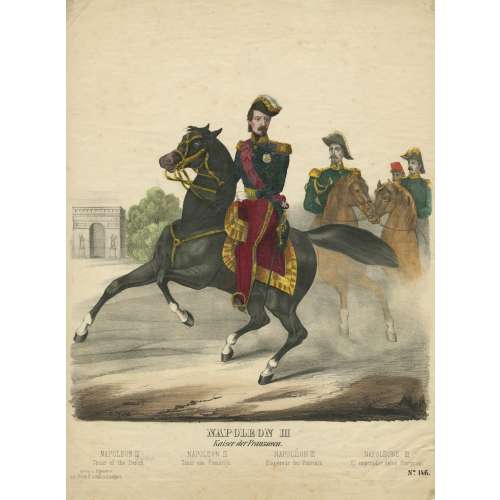 Hand-coloured lithography on wove paper 423 x 332 mm; On reverse: black ink stamp “4956”, ms “A”, ms pencil “428” and “Ernest”. Under the image, centre: "NAPOLEON III | Kaiser der Franzosen." Velow: | NAPOLEON III | Czaar of the French — NAPOLEON III | Czaar van Frankrijk — NAPOLÉON III | Empereur des Francais. — NAPOLEONE III | El emperador delos Franceses; bottom left: "Verlag u. Eigenthum | von. Fried. G. Schulz in Stuttgart.", right: "No 146." The artist's and printer's names in stone are not legible. Published in Stuttgart by Friederich Gustav Schulz (German, 1786 – 1859) during the time of the Second French Empire (1852-1870).
Hand-coloured lithography on wove paper 423 x 332 mm; On reverse: black ink stamp “4956”, ms “A”, ms pencil “428” and “Ernest”. Under the image, centre: "NAPOLEON III | Kaiser der Franzosen." Velow: | NAPOLEON III | Czaar of the French — NAPOLEON III | Czaar van Frankrijk — NAPOLÉON III | Empereur des Francais. — NAPOLEONE III | El emperador delos Franceses; bottom left: "Verlag u. Eigenthum | von. Fried. G. Schulz in Stuttgart.", right: "No 146." The artist's and printer's names in stone are not legible. Published in Stuttgart by Friederich Gustav Schulz (German, 1786 – 1859) during the time of the Second French Empire (1852-1870). -
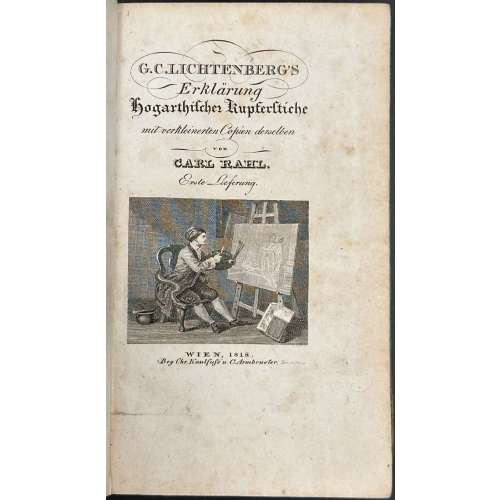 Three hardcover volumes, in-12mo, 16.2 x 10.6 cm each, uniformly bound in quarter brown cloth over marbled boards, all margins marbled, gilt lettering to spine; plus an oblong volume of similar binding, 24.5 x 39.5 cm, with 88 engraved plates by Riepenhausen after Hogarth (83 pp, unnumbered). Catalogue raisonné of William Hogarth's engravings, published by Carl Armbruster in Vienna and Dieterichsche Buchhandlung in Göttingen. A detailed explanation of Hogarth's prints divided in 14 parts. Vol. 1.
Three hardcover volumes, in-12mo, 16.2 x 10.6 cm each, uniformly bound in quarter brown cloth over marbled boards, all margins marbled, gilt lettering to spine; plus an oblong volume of similar binding, 24.5 x 39.5 cm, with 88 engraved plates by Riepenhausen after Hogarth (83 pp, unnumbered). Catalogue raisonné of William Hogarth's engravings, published by Carl Armbruster in Vienna and Dieterichsche Buchhandlung in Göttingen. A detailed explanation of Hogarth's prints divided in 14 parts. Vol. 1.- C. G. Lichtenberg’s Ausführliche Erklärung der Hogarthischen Kupferstiche, mit verkleinerten Copien derselben von Carl Rahl. Erste Lieferung. Wien, 1818. Bey Chr. Kaulfuß und C. Armbruster. Gedruckt bey Anton Strauß. [i-v] vi-xxxvi, [1-3] 4-136, plus engraved t.p.
- C. G. Lichtenberg’s Ausführliche Erklärung der Hogarthischen Kupferstiche, mit verkleinerten Copien derselben von Carl Rahl. Zweite Lieferung. Wien, 1818. Bey Chr. Kaulfuß und C. Armbruster. Gedruckt bey Anton Strauß. [i-iii] iv-viii [2] 11-207 [1 blank], plus engraved t.p.
- C. G. Lichtenberg’s Ausführliche Erklärung der Hogarthischen Kupferstiche, mit verkleinerten Copien derselben von Carl Rahl. Dritte Lieferung. Wien, 1818. Bey Chr. Kaulfuß und C. Armbruster. Gedruckt bey Anton Strauß. [i-iii] iv-vi [3] 10-215 [1 blank], plus engraved t.p.
- C. G. Lichtenberg’s Ausführliche Erklärung der Hogarthischen Kupferstiche, mit verkleinerten Copien derselben von Carl Rahl. Vierte Lieferung. Wien, 1818. Bey Chr. Kaulfuß und C. Armbruster. Gedruckt bey Anton Strauß. [1-5] 6-180 [1 blank], plus engraved t.p.
- C. G. Lichtenberg’s Ausführliche Erklärung der Hogarthischen Kupferstiche, mit verkleinerten Copien derselben von Carl Rahl. Fünste Lieferung. Wien, bey Carl Armbruster 1819. Gedruckt bey Anton Strauß. [1-3] 4-144, plus engraved t.p.
- C. G. Lichtenberg’s Ausführliche Erklärung der Hogarthischen Kupferstiche, mit verkleinerten Copien derselben von Carl Rahl. Sechste Lieferung. Mit zufåßen nach den schriften der englischen Erflårer. Wien, bey Carl Armbruster 1819. Gedruckt bey Anton Strauß. [i-iii] iv-x [2] 13-100, plus engraved t.p.
- C. G. Lichtenberg’s Ausführliche Erklärung der Hogarthischen Kupferstiche, mit verkleinerten Copien derselben von Carl Rahl. Siebente und achte Lieferung. Mit zufåßen nach den Schriften der englischen Erflårer. Wien, bey Carl Armbruster 1820. Gedruckt bey Anton Strauß. [1-8] 9-191, plus engraved t.p.
- C. G. Lichtenberg’s Ausführliche Erklärung der Hogarthischen Kupferstiche, mit verkleinerten Copien derselben von Carl Rahl. Neunte und zehnte Lieferung. Mit zufåßen nach den Schriften der englischen Erflårer. Wien, bey Carl Armbruster 1823. Gedruckt bey Anton Strauß. [1-7] 8-168, plus engraved t.p.
- C. G. Lichtenberg’s Erklärung der Hogarthischen Kupferstiche, mit verkleinerten aber vollständigen Copien derselben von E. Riepenhausen. Eilfte Lieferung mit zufåßen nach den schriften der englischen Erflårer. Göttingen in der Dieterichsche Buchhandlung 1809. [1-3] 4-81 [82 blank].
- C. G. Lichtenberg’s Ausführliche Erklärung der Hogarthischen Kupferstiche, mit verkleinerten aber vollständigen Copien derselben von E. Riepenhausen fortgefeßt vom Berausgeber der fechsten Lieferung mit Benußung der englischen Erflårer. Zwölfte Lieferung. Göttingen in der Dieterichsche Buchhandlung 1816. [i-iii] iv [1-3] 4-76.
- J. P. Lyser’s Ausführliche Erklärung der Hogarthischen Kupferstiche, mit verkleinerten aber vollständigen Copien derselben von E. Riepenhausen. Dreizehnte Lieferung Göttingen in der Dieterichsche Buchhandlung 1833. [i-v] vi-xii, [1-3] 4-117 [118].
- Dr. le Petit’s Ausführliche Erklärung der Hogarthischen Kupferstiche, mit verkleinerten aber vollständigen Copien derselben von E. Riepenhausen, Berausgeber Karl Gutzkow. Vierzehnte Lieferung. Göttingen in der Dieterichsche Buchhandlung 1835. [i-iii] iv-xvi, [1-3] 4-132.
-
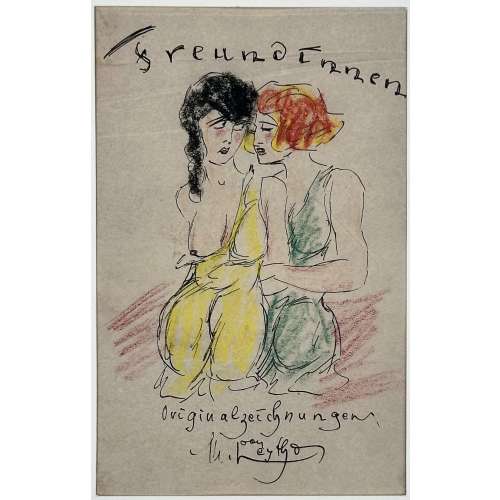 Seven pen and ink and colour crayon drawings on thin wove paper approx. 140 x 100 mm, each attached to a sheet 310 x 240 mm and mounted in a passepartout, placed in an aubergine cardboard folder 310 x 250 mm with a tan vellum spine and paper flaps inside; olive label with double border and gilt lettering to front cover "Dessins" [Drawings]. The first sheet is a title-page lettered in manuscript: Freundinnen | {vignette} | Originalzeichnungen | M. Leytho || [Girlfriends. Original drawings]. Information about the artist at www.honesterotica.com: "Mitja Leytho, almost certainly a pseudonym, is yet another mediocre yet fascinating amateur artist from the Germany of the 1920s about whom we know absolutely nothing beyond the four portfolios which bear the ‘Leytho’ signature". We shall notice that this set of drawings was produced by a talented professional, not an amateur.
Seven pen and ink and colour crayon drawings on thin wove paper approx. 140 x 100 mm, each attached to a sheet 310 x 240 mm and mounted in a passepartout, placed in an aubergine cardboard folder 310 x 250 mm with a tan vellum spine and paper flaps inside; olive label with double border and gilt lettering to front cover "Dessins" [Drawings]. The first sheet is a title-page lettered in manuscript: Freundinnen | {vignette} | Originalzeichnungen | M. Leytho || [Girlfriends. Original drawings]. Information about the artist at www.honesterotica.com: "Mitja Leytho, almost certainly a pseudonym, is yet another mediocre yet fascinating amateur artist from the Germany of the 1920s about whom we know absolutely nothing beyond the four portfolios which bear the ‘Leytho’ signature". We shall notice that this set of drawings was produced by a talented professional, not an amateur. -
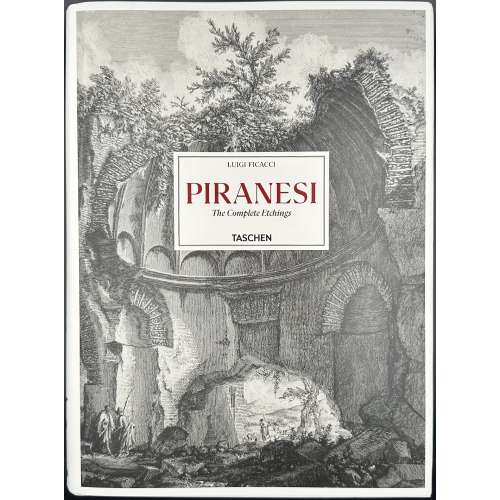 Hardcover volume, 35 x 26 cm, bound in pictorial paper boards with a lettered label to front cover, black lettering to spine, pictorial dust jacket, pictorial endpapers, pp.: [1-5] 6-787 [788], 1028 colour ils., trilingual edition (English, German, French). Title-page (red and black): LUIGI FICACCI | ISTITUTO NAZIONALE PER LA GRAFICA, ROME | Giovanni Battista | PIRANESI | Catalogue of the Complete Etchings | Gesamtkatalog der Radierungen | Catalogue raisonné des eaux-fortes | TASCHEN || Contributors: Luigi Ficacci (Italian, b. 1954) – author. Giovanni Battista [Giambattista] Piranesi (Italian, 1720 – 1778) – artist.
Hardcover volume, 35 x 26 cm, bound in pictorial paper boards with a lettered label to front cover, black lettering to spine, pictorial dust jacket, pictorial endpapers, pp.: [1-5] 6-787 [788], 1028 colour ils., trilingual edition (English, German, French). Title-page (red and black): LUIGI FICACCI | ISTITUTO NAZIONALE PER LA GRAFICA, ROME | Giovanni Battista | PIRANESI | Catalogue of the Complete Etchings | Gesamtkatalog der Radierungen | Catalogue raisonné des eaux-fortes | TASCHEN || Contributors: Luigi Ficacci (Italian, b. 1954) – author. Giovanni Battista [Giambattista] Piranesi (Italian, 1720 – 1778) – artist. -
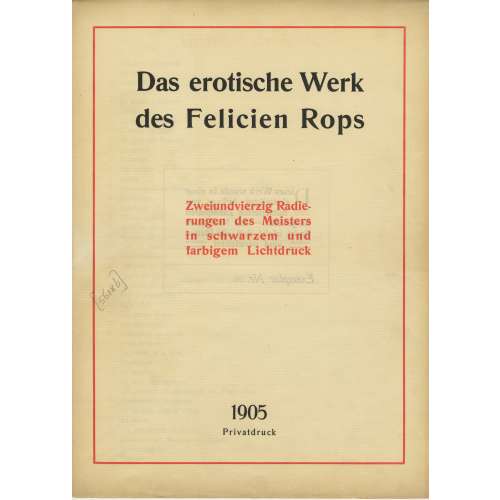
A limited-edition (№26/500) set of 42 etchings and drypoints after Félicien Rops (Belgian, 1833 – 1898), each mounted in a numbered passe-partout, printed posthumously by an anonym in Germany in 1905; in a flapped half faux suede-backed cardboard portfolio with straps, 442 x 335 mm, red embossed lettering to the front cover, bookplate of Richard Teschner (Austrian, 1879 – 1948) pasted inside.
Title-page (in a red frame): Das erotische Werk | des Felicien Rops | Zweiundvierzig Radie- | rungen des Meisters | in schwarzem und | farbigem Lichtdruck | 1905 | Privatdruk ||
Limitation (in a red two-section frame) : Dieses Werk wurde in einer | einmaligen Auflage von | 500 numerierten Exemplaren | hergestellt. — Ein Nachdruck | findet nicht statt, die Platten | == sind vernichtet == | Exemplar Nr. 26 ||
Verzeichnis der Tafeln (Table of Contents): 1. Initiation sentimentale; 2. La croix; 3. Entre-acte; 4. Holocauste; 5. La bonne hollandaise; 6. Étude; 7. La femme au pantin; 8. L’amour de Satan; 9. Au pays des féminies; 10. La volupté; 11. Evocation; 12. De castitate; 13. Joujou; 14. Vengeance d’une femme; 15. Phantasies; 16. Indolence; 17. Théâtre gaillard; 18. Appel au peuple; 19. Masques modernes; 20. Tout est grand chez les rois; 21. Marie-Madeleine; 22. L’amante du Christ; 23. Feuille de vigne; 24. La messe de Guide; 25 Viol et prostitution; 26. Le maillot; 27. Les jeunes France; 28. Les diaboliques; 29. Coquetterie au miroir; 30. Jeune homme; 31. La femme et la mort; 32. Confidence; 33. La bergère; 34. La mère aux satyrions; 35. Les exercices de dévotion de Mr. Henri Roch; 36. Mademoiselle de Maupin; 37. Le bonheur dans le crime; 38. La sirène; 39. Les cabotinages de l’amour; 40. Document sur l’impuissance d’aimer; 41. A cœur perdu; 42. Curieuse.
-
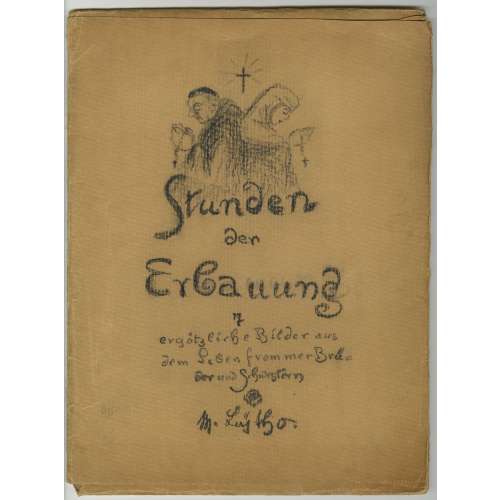 Flapped folder of thick embossed paper 353 x 263 mm, with a vignette and manuscript to front: Stunden der Erbauung | 7 | ergötz liebe Bilder aus | dem Leben frommer Brü | der und Schwestern | • | M. Leÿtho. ||, six graphite pencil drawings, each glued to a paper sheet with guard tissue; mat size 339 x 253 mm mat; drawing size 220 x 165 mm. Translation of the title: Hours of Edification / 7 delightful pictures from the lives of pious brothers and sisters. Information about the artist at www.honesterotica.com: "Mitja Leytho, almost certainly a pseudonym, is yet another mediocre yet fascinating amateur artist from the Germany of the 1920s about whom we know absolutely nothing beyond the four portfolios which bear the ‘Leytho’ signature".
Flapped folder of thick embossed paper 353 x 263 mm, with a vignette and manuscript to front: Stunden der Erbauung | 7 | ergötz liebe Bilder aus | dem Leben frommer Brü | der und Schwestern | • | M. Leÿtho. ||, six graphite pencil drawings, each glued to a paper sheet with guard tissue; mat size 339 x 253 mm mat; drawing size 220 x 165 mm. Translation of the title: Hours of Edification / 7 delightful pictures from the lives of pious brothers and sisters. Information about the artist at www.honesterotica.com: "Mitja Leytho, almost certainly a pseudonym, is yet another mediocre yet fascinating amateur artist from the Germany of the 1920s about whom we know absolutely nothing beyond the four portfolios which bear the ‘Leytho’ signature". -
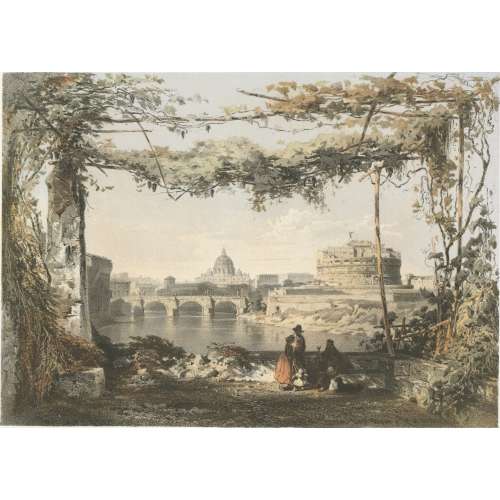
Sheet № 20 from the series of 42 сhromolithography prints 'Skizzen und Bilder aus ROM und der Umgegend' (Sketches and pictures from Rome and surroundings).
Inscriptions:
Top left: LINDEMANN-FROMMEL’S Top right: Skizzen und Bilder aus ROM und der Umgegend. Centre below: No 20 | IL CASTEL E IL PONTE SANT ANGELO, | E SAN PIETRO. Bottom left: Imp. de JACOMME et Cie. R. de Lancry, 16 Paris. Bottom centre: Stuttgart, bei FRANZ KÖHLER. Bottom right: Paris, Goupil et Cie. Editeurs.Dimensions:
Plate: 372 x 473 mm Sheet: 372 x 473 mm
Contributors:
Lindemann-Frommel, Karl (French-German, 1819 – 1891) – artist. Jacomme, Claude (French, fl. 1838 – 1857) – printer/lithographer. Goupil et Cie (Paris); Goupil, Adophe (French, 1806 – 1893) – publisher Franz Köhler (Stuttgart); Köhler, Franz (German, 1805 – 1872) – publisher. -
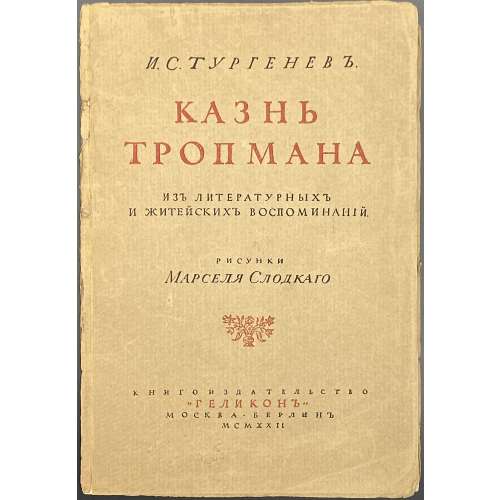 Paperback brochure, 22.6 x 16 cm, brown wrappers, lettered in red and black: И. С. ТУРГЕНЕВЪ. | КАЗНЬ | ТРОПМАНА | ИЗЪ ЛИТЕРАТУРНЫХЪ | И ЖИТЕЙСКИХЪ ВОСПОМИНАНIЙ. | РИСУНКИ | Марселя Слодкаго | {fleuron} | КНИГОИЗДАТЕЛЬСТВО | «ГЕЛИКОНЪ» | МОСКВА - БЕРЛИНЪ | MCMXXII ||; 8 full-page, incl. frontispiece, and 5 smaller vignettes after Marcel Slodki, within pagination. Title-page: И. С. ТУРГЕНЕВЪ. | КАЗНЬ | ТРОПМАНА | ИЗЪ ЛИТЕРАТУРНЫХЪ | И ЖИТЕЙСКИХЪ ВОСПОМИНАНIЙ | Рисунки | МАРСЕЛЯ СЛОДКАГО. | Книгоиздательство | “ГЕЛИКОНЪ” | МОСКВА - БЕРЛИНЪ | MCMXXII || Imprint: Эта книга отпечатана въ типографiи Sinaburg & Co., G.m.b.H. | Berlin для книгоиздательства “Геликонъ” в декабрѣ | 1921 г. Клише работы Römmler & Jonas, Dresden. || Pagination: [4] blanks, [2] publisher’s device / imprint, [2] blank / frontis. (Turgenev’s portrait), [2] t.p. / blank, [2] f.t. / blank, 11-57 [58] text, [4] blanks. Contributors: Иван Сергеевич Тургенев [Ivan Turgenev] (Russian, 1818 – 1883) – author. Марсель Слодкий [Marcel Slodki] (Jewish-Ukrainian, 1892 – 1944) – artist Jean-Baptiste Troppmann (French, 1849 – 1870) – character.
Paperback brochure, 22.6 x 16 cm, brown wrappers, lettered in red and black: И. С. ТУРГЕНЕВЪ. | КАЗНЬ | ТРОПМАНА | ИЗЪ ЛИТЕРАТУРНЫХЪ | И ЖИТЕЙСКИХЪ ВОСПОМИНАНIЙ. | РИСУНКИ | Марселя Слодкаго | {fleuron} | КНИГОИЗДАТЕЛЬСТВО | «ГЕЛИКОНЪ» | МОСКВА - БЕРЛИНЪ | MCMXXII ||; 8 full-page, incl. frontispiece, and 5 smaller vignettes after Marcel Slodki, within pagination. Title-page: И. С. ТУРГЕНЕВЪ. | КАЗНЬ | ТРОПМАНА | ИЗЪ ЛИТЕРАТУРНЫХЪ | И ЖИТЕЙСКИХЪ ВОСПОМИНАНIЙ | Рисунки | МАРСЕЛЯ СЛОДКАГО. | Книгоиздательство | “ГЕЛИКОНЪ” | МОСКВА - БЕРЛИНЪ | MCMXXII || Imprint: Эта книга отпечатана въ типографiи Sinaburg & Co., G.m.b.H. | Berlin для книгоиздательства “Геликонъ” в декабрѣ | 1921 г. Клише работы Römmler & Jonas, Dresden. || Pagination: [4] blanks, [2] publisher’s device / imprint, [2] blank / frontis. (Turgenev’s portrait), [2] t.p. / blank, [2] f.t. / blank, 11-57 [58] text, [4] blanks. Contributors: Иван Сергеевич Тургенев [Ivan Turgenev] (Russian, 1818 – 1883) – author. Марсель Слодкий [Marcel Slodki] (Jewish-Ukrainian, 1892 – 1944) – artist Jean-Baptiste Troppmann (French, 1849 – 1870) – character. -
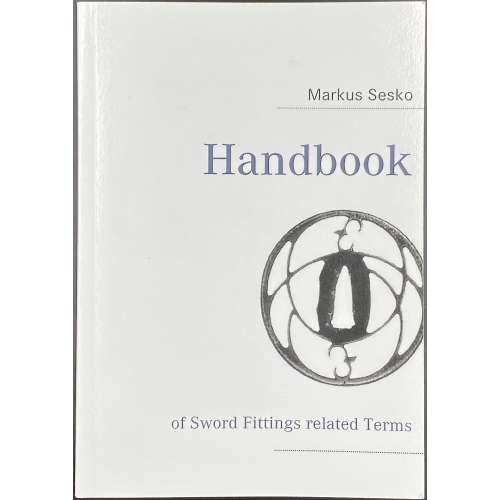 Softcover, 21 x 14.8 cm, print on demand edition, pp.: 1-88 [2], total 90 pages, pp. 1, 2, 88, and 89 blanks, p. 90 colophon. Font cover: Markus Sesko | — | Handbook | {vignette} | of Sword Fittings related Terms | — || Title-page: Handbook | of Sword Fittings | related Terms | © 2011 Markus Sesko | Herstellung und Verlag: | Books on Demand GmbH, Norderstedt | ISBN 978-308423-6422-6 || On the back cover: Blurb, publisher’s device in blue and black, barcode, and web address. Lettering to spine. Printed in the USA.
Softcover, 21 x 14.8 cm, print on demand edition, pp.: 1-88 [2], total 90 pages, pp. 1, 2, 88, and 89 blanks, p. 90 colophon. Font cover: Markus Sesko | — | Handbook | {vignette} | of Sword Fittings related Terms | — || Title-page: Handbook | of Sword Fittings | related Terms | © 2011 Markus Sesko | Herstellung und Verlag: | Books on Demand GmbH, Norderstedt | ISBN 978-308423-6422-6 || On the back cover: Blurb, publisher’s device in blue and black, barcode, and web address. Lettering to spine. Printed in the USA. -
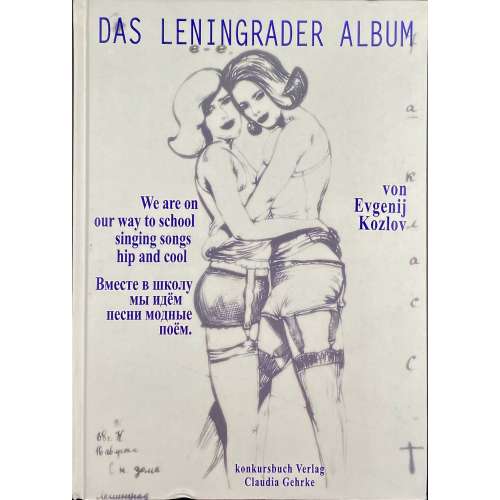 Hardcover volume, 24.5 x 17.5 cm, pictorial boards and endpapers, pp. [2] 3-167 [168]; 2 t.p., 129 pp. of plates, 33 pp. of text, 4 pp. of thumbnails, 1 colophon. Front cover (grey vignette, blue lettering): Das Leningrader Album | We are on | our way to school | singing songs | hip and cool | Вместе в школу | мы идём | песни модные | поём. | von | Evgenij | Kozlov | konkursbuch Verlag | Claudia Gehrke || ISBN: 3-88769-315-9. Evgenij Kozlov (Russian-German, b. 1955) – artist.
Hardcover volume, 24.5 x 17.5 cm, pictorial boards and endpapers, pp. [2] 3-167 [168]; 2 t.p., 129 pp. of plates, 33 pp. of text, 4 pp. of thumbnails, 1 colophon. Front cover (grey vignette, blue lettering): Das Leningrader Album | We are on | our way to school | singing songs | hip and cool | Вместе в школу | мы идём | песни модные | поём. | von | Evgenij | Kozlov | konkursbuch Verlag | Claudia Gehrke || ISBN: 3-88769-315-9. Evgenij Kozlov (Russian-German, b. 1955) – artist. -
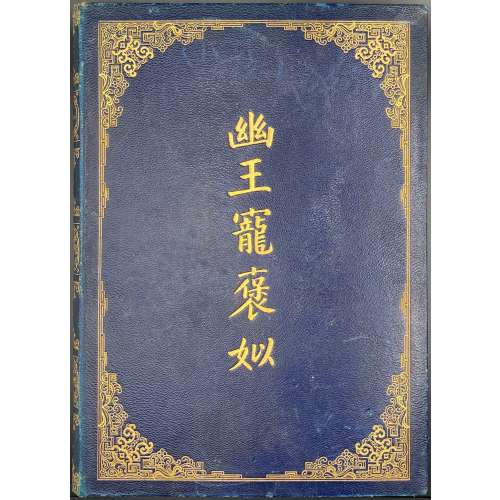 Description: Hardcover, in-folio, 32 x 23.5 cm, bound in dark blue morocco, boards and spine richly decorated in gilt, front cover gilt-lettered in Chinese [幽王寵褒姒], pictorial endpapers, laid paper with unicorn watermark, margins uncut, printing performed by Joh. Enschedé (Haarlem), pp. [10] 1-210 [6], total 226 pages, collated π5 1-532 χ2, first and last leaves blank, total 113 leaves plus 7 plates after Franz von Bayros, some signed; adorned with woodcut borders, frames, head- and tailpieces throughout. The binding work was done by Hübel und Denck (Leipzig) based on designs by Paul Renner. Title-page: DAS | SCHÖNE | MÄDCHEN | VON PAO | — | EIN CHINESISCHER | ROMAN VON | OTTO JULIUS BIERBAUM | — | PRACHTAUSGABE | MIT BILDERN VON BAYROS | — | Bei Joh. Enschedé en Zonen in | Haarlem gedruckt für Georg | Müllers Verlag in München || Catalogue raisonné: The amorous drawings of the Marquis von Bayros. — New York: Cythera Press, 1968. The Beautiful Maiden of Pao, pp. 153-8. Contributors: Otto Julius Bierbaum (German, 1865 – 1910) – author. Franz von Bayros (Austrian, 1866 – 1924) – artist. Johannes Enschedé (Dutch, 1708 – 1780) – printer. Joh. Enschedé (Haarlem) – printer. Hübel und Denck (Leipzig) – bookbinder. Paul Friedrich August Renner (German, 1878 – 1956) – designer.
Description: Hardcover, in-folio, 32 x 23.5 cm, bound in dark blue morocco, boards and spine richly decorated in gilt, front cover gilt-lettered in Chinese [幽王寵褒姒], pictorial endpapers, laid paper with unicorn watermark, margins uncut, printing performed by Joh. Enschedé (Haarlem), pp. [10] 1-210 [6], total 226 pages, collated π5 1-532 χ2, first and last leaves blank, total 113 leaves plus 7 plates after Franz von Bayros, some signed; adorned with woodcut borders, frames, head- and tailpieces throughout. The binding work was done by Hübel und Denck (Leipzig) based on designs by Paul Renner. Title-page: DAS | SCHÖNE | MÄDCHEN | VON PAO | — | EIN CHINESISCHER | ROMAN VON | OTTO JULIUS BIERBAUM | — | PRACHTAUSGABE | MIT BILDERN VON BAYROS | — | Bei Joh. Enschedé en Zonen in | Haarlem gedruckt für Georg | Müllers Verlag in München || Catalogue raisonné: The amorous drawings of the Marquis von Bayros. — New York: Cythera Press, 1968. The Beautiful Maiden of Pao, pp. 153-8. Contributors: Otto Julius Bierbaum (German, 1865 – 1910) – author. Franz von Bayros (Austrian, 1866 – 1924) – artist. Johannes Enschedé (Dutch, 1708 – 1780) – printer. Joh. Enschedé (Haarlem) – printer. Hübel und Denck (Leipzig) – bookbinder. Paul Friedrich August Renner (German, 1878 – 1956) – designer. -
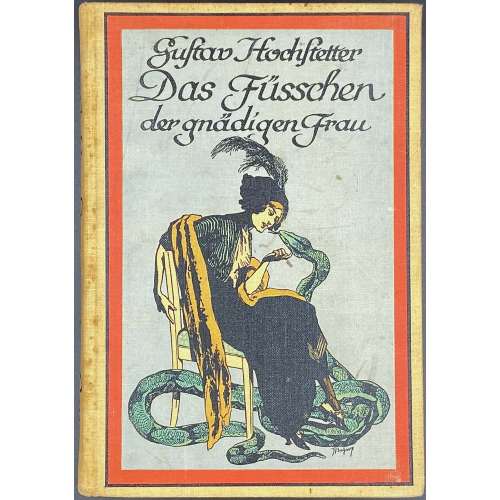 Description: Hardcover, 18.8 x 13 cm, pictorial front cover (after Franz von Bayros) in colour over tan cloth, lettering to spine, all margins red, laid paper endpapers, pp.: [4] 1-185 [3]; collated 8vo as π2 1-118, 126, total 192 pages (96 leaves) plus 5 b/w photogravures after drawings by Franz von Bayros. Title-page (blackletter): Gustav Hochstetter | Das Füsschen der gnädigen Frau | und Anderes | {publisher’s device} | {blank} | 1912 | München und Leipzig bei Georg Müller || T.p. verso (blackletter): Umschlagzeichnung und fünf Bildbeigeben von | Franz von Bayros | {blank} | (serif) Copyright 1912 by Georg Müller in München || Colophon: Druck von Mänicke u. Jahn, Rudolstadt. Contributors: Gustav Hochstetter (German-Jewish, 1873 – 1944) – author. Franz von Bayros (Austrian, 1866 – 1924) – artist. Mänicke und Jahn (Rudolstadt) – printer. Georg Müller (München, Leipzig) – publisher.
Description: Hardcover, 18.8 x 13 cm, pictorial front cover (after Franz von Bayros) in colour over tan cloth, lettering to spine, all margins red, laid paper endpapers, pp.: [4] 1-185 [3]; collated 8vo as π2 1-118, 126, total 192 pages (96 leaves) plus 5 b/w photogravures after drawings by Franz von Bayros. Title-page (blackletter): Gustav Hochstetter | Das Füsschen der gnädigen Frau | und Anderes | {publisher’s device} | {blank} | 1912 | München und Leipzig bei Georg Müller || T.p. verso (blackletter): Umschlagzeichnung und fünf Bildbeigeben von | Franz von Bayros | {blank} | (serif) Copyright 1912 by Georg Müller in München || Colophon: Druck von Mänicke u. Jahn, Rudolstadt. Contributors: Gustav Hochstetter (German-Jewish, 1873 – 1944) – author. Franz von Bayros (Austrian, 1866 – 1924) – artist. Mänicke und Jahn (Rudolstadt) – printer. Georg Müller (München, Leipzig) – publisher. -
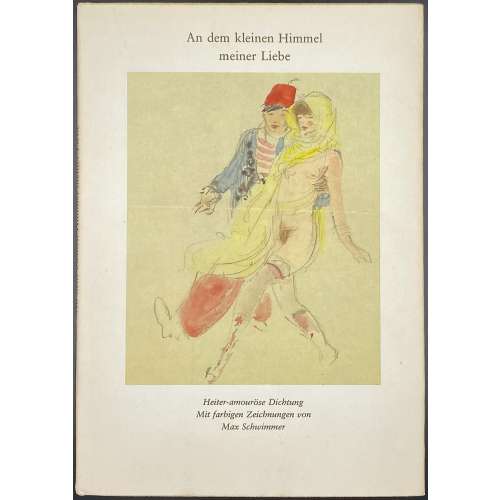 Description: bound in light yellow cloth with red and orange geometrical design to front cover and black lettering to spine, in pictorial DJ “An dem kleinen Himmel | meiner Liebe | {colour vignette} | Heiter-amouröse Dichtung | Mit 24 farbigen Zeichnungen von | Max Schwimmer”; pp.: [1-6] 7-95 [96], total 48 leaves, with 22 offset colour full-page illustrations, DJ and title-page vignettes by Max Schwimmer; plates with pagination. Anthology of German love poetry from Caspar Stieler (1632 – 1707) to Wolfgang Tilgner (1932 – 2011). Title-page: An dem kleinen Himmel | meiner Liebe | Heiter-amouröse Dichtung | Mit 24 farbigen Zeichnungen | von Max Schwimmer | {vignette} | Verlag der Nation | Berlin || Contributors: Bruno Brandl (German, fl. c. 1969 – 1991)– editor. Max Schwimmer (German, 1895 – 1960) – artist. VEB Druckhaus “Maxim Gorki” (Altenburg) – printer. Verlag der Nation (Berlin) – publisher.
Description: bound in light yellow cloth with red and orange geometrical design to front cover and black lettering to spine, in pictorial DJ “An dem kleinen Himmel | meiner Liebe | {colour vignette} | Heiter-amouröse Dichtung | Mit 24 farbigen Zeichnungen von | Max Schwimmer”; pp.: [1-6] 7-95 [96], total 48 leaves, with 22 offset colour full-page illustrations, DJ and title-page vignettes by Max Schwimmer; plates with pagination. Anthology of German love poetry from Caspar Stieler (1632 – 1707) to Wolfgang Tilgner (1932 – 2011). Title-page: An dem kleinen Himmel | meiner Liebe | Heiter-amouröse Dichtung | Mit 24 farbigen Zeichnungen | von Max Schwimmer | {vignette} | Verlag der Nation | Berlin || Contributors: Bruno Brandl (German, fl. c. 1969 – 1991)– editor. Max Schwimmer (German, 1895 – 1960) – artist. VEB Druckhaus “Maxim Gorki” (Altenburg) – printer. Verlag der Nation (Berlin) – publisher.


